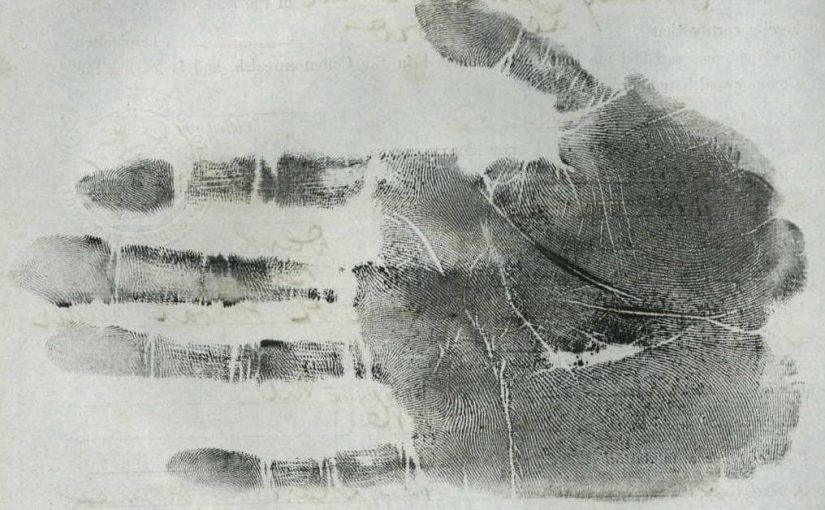When I enrolled in Exploring Digital Heritage this semester and saw the documents we would help transcribe and analyse, I experienced what I call the six degrees of fingerprints.
Initially, I thought about how the records in the White Australia Policy were like an early form of passport and wondered how passports developed.
I quickly realised the policy was about restricting immigration to people who were deemed European.
The documents within Series ST84/1 demonstrate the policy was not only applied to new immigrants but also to Australian born individuals of non-European descent because of their non-European appearance.
Documents surrounding held data on individuals interest me. They hold power, they tell us stories, they can transport us through time, they can separate us from one another; but they can also bring us together.
These documents, many with fingerprints/handprints, transported me back to 2008 when I myself experienced Australian immigration. It isn’t an easy process, there is a mountain of paperwork, expensive fees, a medical, invasive questions, a police check, photographs, and then there is the fingerprinting.
I walked into my nearest police station and awkwardly stepped up to the clerk and explained that I was immigrating to Australia and I needed to be fingerprinted as part of the application. The clerk looked at me with a puzzled expression, looked at the paperwork, looked at me, and back at the paperwork. She turned to a colleague who looked at the paperwork and looked at me with an equally perplexed countenance.
I was eventually called into a room where an astonished policeman placed the ink and paper in front of me but refused to fingerprint me. He had never fingerprinted an innocent person and wasn’t about to do so now. He explained what I needed to do and observed my efforts at fingerprinting myself. I then paid the station for said fingerprints and sent them off with my application.
At the time, I figured I had nothing to hide, and I wanted to move to Australia so I could live with my Australian born husband. Nonetheless, the process of immigrating inadvertently segregated me, it reduced me to an untrustworthy part of Australian society. Fingerprinting made me feel like a criminal despite having no criminal past.
I often wonder why my fingerprints were necessary considering I had a police check. Why are my fingerprints on file when Australian fingerprints are not? Will my personal files show up in an archive one day for people to search through? Will my fingerprints be there telling a little piece of my experience, my story of immigration to Australia?
My sense of isolation culminated after about six months of living in Australia. I was frustrated, angry, and I felt I had nowhere to turn for help. All I wanted was to contribute, to feel a part of Australian society. Unintentional as it was, I was often reminded in one way or another that I was not Australian. How much more so must the Australian’s in the Series ST84/1 documents have felt alienated by their own government.
Eventually, I got a part time job and was befriended by Australians, both of which helped bridge the gap. It was through research however, that I got back a sense of self-worth, a sense of contributing to something special. I began researching a relative who fought in WWII as a tail gunner in a Lancaster bomber, and I decided to extend my research to include the whole crew.
Getting their records from the archives in Canada and the UK took many months. Nothing was digitised or transcribed. I had no idea what these documents would look like nor how much they would cost. About three months later and nearly one thousand dollars charged to my credit card, I received a hefty box full of service records.
When I opened that box of documents, I opened the door to marginalised servicemen who didn’t live long enough to make their mark in the history books. However, reading their files and writing about their lives made a huge impact on me, and I’m hoping reading and transcribing documents from Series ST84/1 might make an impact on you.
I have many fond, memorable experiences of reading through the 600 plus pages of archival service records. I turned page after page, reading document after document which included information such as eye colour, hair colour, religious affiliations, next of kin, training reports, missing in action reports and in some instances, fingerprints.
I’ll never forget experiencing those first set of fingerprints. I instinctively reached out my hand to place my fingers over those on the page. What transpired in a fraction of an instant I can only describe as electric. It was as though the page itself had dissolved, my hand passed through time, and I touched the warm, three-dimensional living flesh that had once belonged to those fingerprints.
The Series ST84/1 documents that make up part of the records of the White Australian Policy have the ability, through your help, to tell their story. However, with the benefit of computer technology and transcription, they will become a searchable database and present the possibility of seeing the records in new ways such as mapping early employment or travel to and from Australia. At bare minimum, relatives of these many Australians will thank you in assisting to make their search for their relative much easier.
Regardless of our citizenship, appearance, job or education, we all have the chance through transcription to touch the past and leave our fingerprints on these records for future generations to research. I Invite you to share in a little piece of history by contributing to the transcription of the White Australia Policy documents. Whether you spend ten minutes or many hours, even a small amount will lead to telling their story.


One thought on “The Six Degrees of Fingerprints: Leave your Fingerprint!”